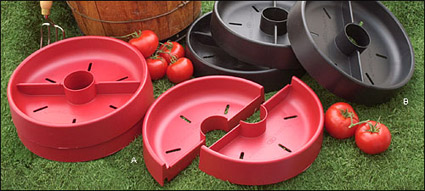It’s really far too early to start getting supplies or thinking about tomatoes but with the weather outside being in the minus kill-me-nows I can’t help but start peaking at the Lee Valley catalog.
I’ve already decided that I’m going to sacrifice a couple of my tomato plants to “research” and give red plastic mulch a go this year. I don’t know how much a layer of bright red plastic jives with my growing style or sense of taste — I like my understated and soil-building straw thank you very much — but this is one of those gardening concepts that is so loudly touted as “Research proven!” that I figure it’s about time to take a crack at it and see for myself.

These Tomato Craters seem neat however they are not cheap and I already have my dependable and totally free water bottle funnel system (it’s basically this project without the cap intact) and trusty toilet paper tube cutworm barrier. I’ve never lost a plant to a cutworm yet. Research proven!!
Gayla I can’t help but notice your Freudian typo…peek vs. peak. Very appropriate! ha
(At first I thought you were going to be writing about that horrible red mulch you see in most subdivisions surrounded by beds of impatiens en masse.)
Oh Amy I am the queen of Freudian slips! I have made up whole words and sayings through slips of the tongue and keyboard. I can’t change that typo now can I?
Oh I really dislike that mulch and have a personal mission to stop people from using it. So you can see why a layer of red plastic doesn’t appeal.
I know that red light reflected from the plastic will be great for your tomato plants, but it has some drawbacks. The plastic material can foster fungal growth, and since it won’t ever break down, it can’t improve your soil structure like organic mulch will.
I hope it isn’t too early, because I’m guilty of it too. I’ve had seeds organized for months.
Cate: I can see the fungal problem. There are others that I can predict too like all the slugs that are bound to hang out under there… My guess is that it might be more successful and less detrimental for my container-grown plants.
I’m not expecting it to surpass natural mulch for all of those reasons and more but my attitude is that I can’t tell people about it one way or another with any authortity until I actually try it myself.
I’m very interested to see the results of your research. Oh, and I love your book, it has helped me so much.I was just wondering if the red dyed mulch is bad or if it’s ok to use. Thanks!
Shelly: They say the red dye is made of non-toxic dyes but the question I have is why bother? I find the colour is too strong and fake looking, it dyes your hands and arms when you handle it, and it’s an extra, unnecessary step in the manufacturing process.